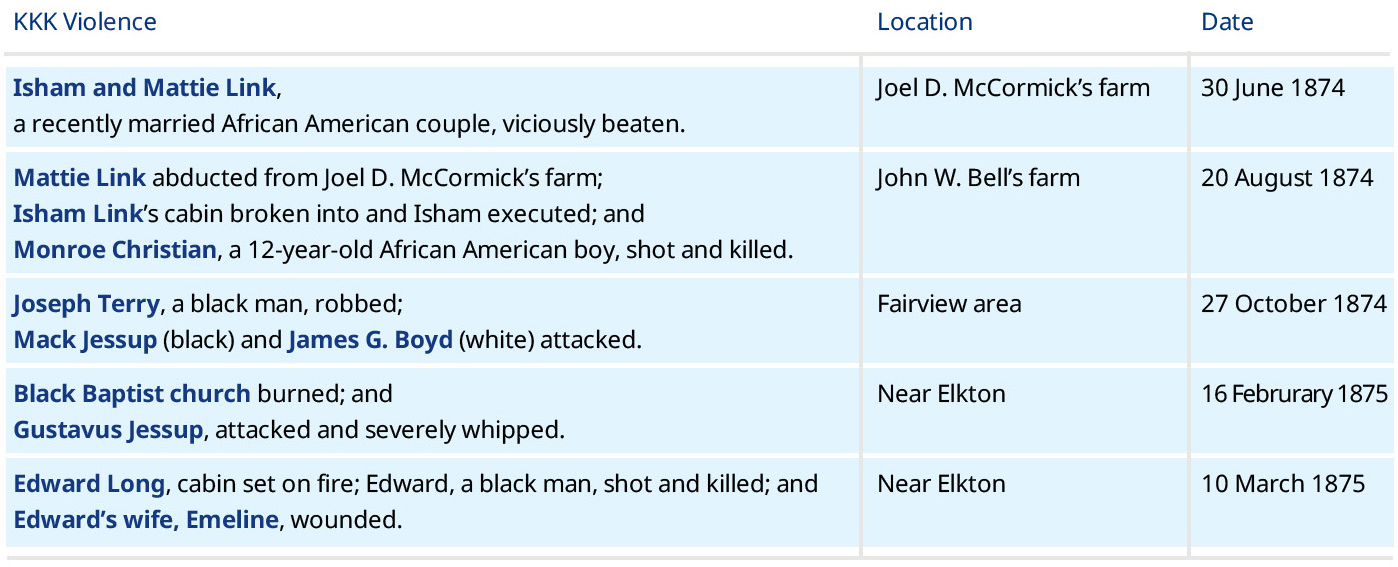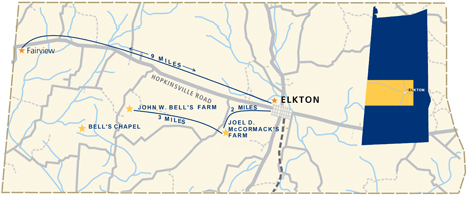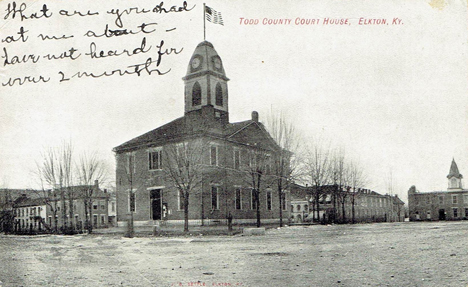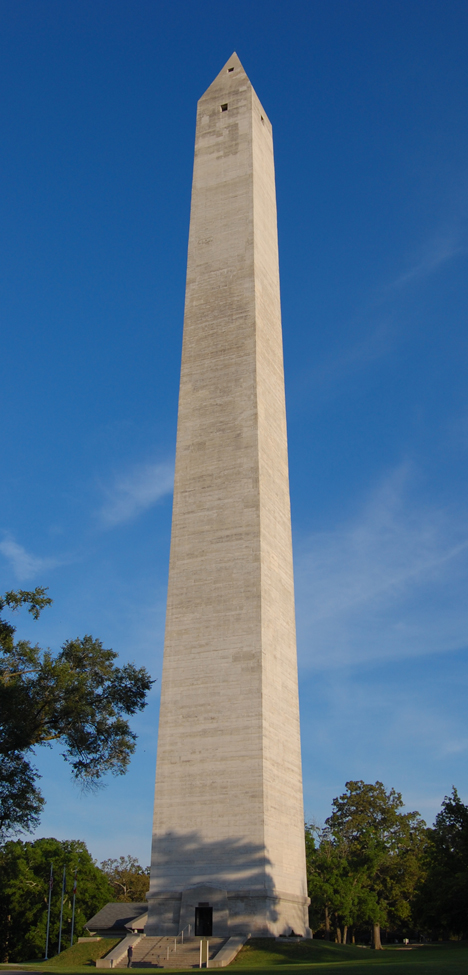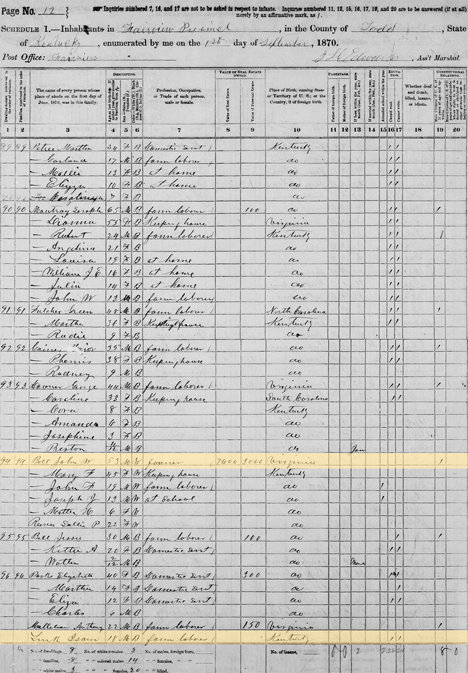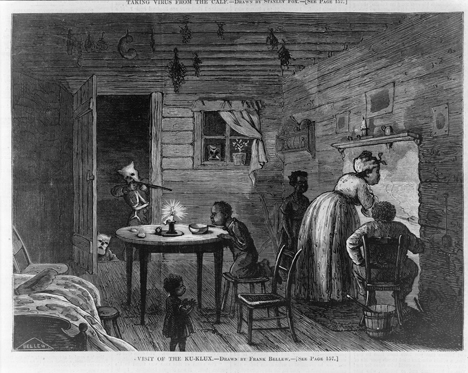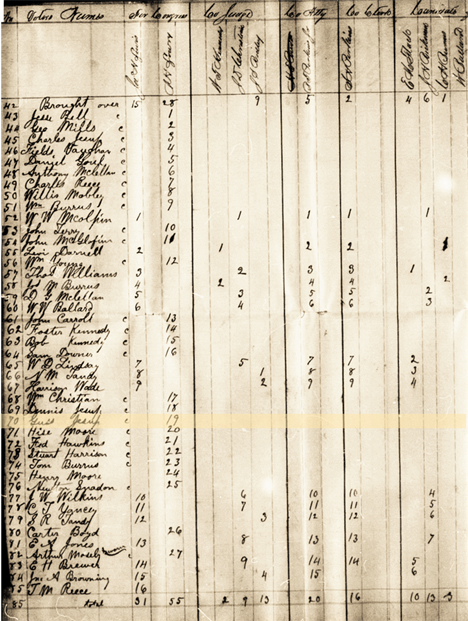


Inset from the Beers and Lanagan 1878 map of Christian county, showing Jefferson Davis’ birthplace in Fairview
1878/Library of Congress
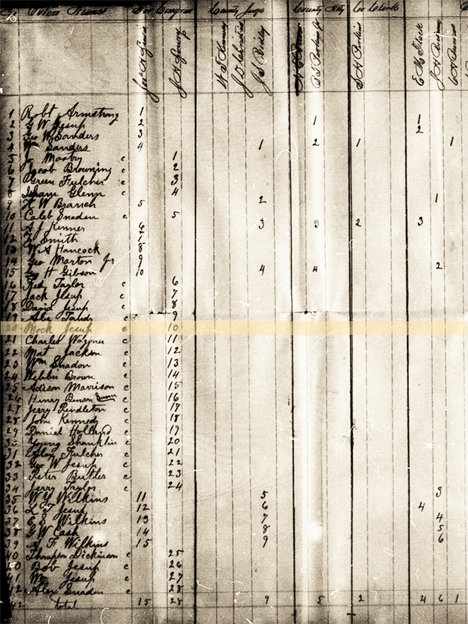
The poll book from Fairview for the April 1870 congressional election showing Mack Jessup’s vote
April 25, 1870
A Vicious Response
Ku Klux Klan Attacks on Black Citizens, 1874-1875
KKK terrorizes Todd County but black voters still turn out
Over two years — 1874 and 1875 — the Ku Klux Klan was an active force in Todd County, terrorizing newly-enfranchised African Americans. The Klan launched five major raids, always under cover of darkness. The Klan did not seem to specifically target black men exercising their new franchise rights. The most frequent and enthusiastic black voters were not Klan targets. Rather, the Klan’s viciousness was born of personal feuds inflamed by former slaves exercising their new legal rights as a free people, especially if the activists were black women.
Nonetheless, the attacks had a chilling effect on black voting in the areas nearest the attacks.
Klan Territory
The rural areas between the towns of Elkton and Fairview were the focus of Klan activity. This was an area midway between the fertile tobacco producing region in the south of the county and the overwhelmingly white farming region to the north of the county. That areas around Elkton and Fairview were centers of Klan activity reflected their political significance. Elkton was the county seat. The county court system, which concentrated all power in the town chosen as the county seat, made Elkton the focus of all political contention. Fairview was the birthplace of Jefferson Davis, the only president of the Confederacy. While the formal commemoration of Davis’ birthplace came in the twentieth century, the connection between Fairview and Davis was widely honored during and after the Civil War.
A Klan Murder
Over its five years of terrorism, the white men of the Todd County Ku Klux Klan killed at least five innocent people. Their most premeditated murder was the execution of Isham Link in August 1874, which was detailed in The New York Times (November 29, 1874, p7).
In 1870, Link worked for John W. Bell, a prosperous farmer in Fairview district, very close to Bell’s Chapel. Link is recorded in the 1870 Census only a few lines below his boss, Bell. While only 18 that year, Isham stood out: he was one of the first black men to join the Todd County militia, previously all-white and still 90 percent so. In a culture of slavery, the main job of the county militia was to maintain slavery. No longer. As the county militias were mobilized in answer to different threats, Isham intended to contribute to a new militia that would ensure the safety of all residents of Todd County.
In October 1872, Isham married Mattie Long, 16, at Bell’s Chapel. They took up residence in a cabin on a farm owned by Joel D. McCormick in the Fairview district, about two miles west of Elkton and not far from John W. Bell’s farm where Isham had previously worked.
On the night of Tuesday June 30, 1874, with the light of the full moon, fifteen to twenty Klansmen, all masked and disguised, arrived at the McCormick farm and broke into the cabin occupied by Mattie and Isham.
The attack, like other KKK moonlight attacks on individual farms in the countryside, was terrifying by design: a dozen or more white men on horseback, in their robes and animal masks and fully armed, bursting into the small cabins in which black families were sleeping. They killed, beat, threatened, and abused at will. They were avengers from the past, flailing, and revealing in the terror they imposed their own fears of a terrifying future defined by equity.
Initially, Mattie escaped and ran toward the McCormick house. “Three or four” Klansmen caught her and “stamped her.” Joel D. McCormick rushed out with his pistol and the masked men retreated. But nine other Klansmen seized Isham, stripped and whipped him, told him they would come again to whip his wife and kill her (The Louisville Daily Commercial, July 4, 1874).
In a courageous act of defiance, Isham and Mattie went to Elkton and reported the attack to the authorities.They swore out an affidavit “for the arrest of the five or six they were able to certainly identify for KluKluxing, which is a penitentiary offense.” (The Louisville Daily Commercial, September 22, 1874).
The second attack, again under the cover of darkness, by a dozen or so Klansmen on horseback came six weeks after the first, on August 20, 1874. Mattie was still at McCormick’s farm; Isham was elsewhere. Mattie was asleep when the Klan arrived and broke into the cabin. Finding Isham absent, the Klansmen took Mattie captive, placed her on a horse behind one of the masked men, “forced her to travel with them three miles [to John W. Bell’s farm], and forced her to show them where her husband was” (The Louisville Courier-Journal, August 31, 1874).
The Elkton Witness, a short-lived newspaper published by Dr. J. W. Cox, published a detailed account of what happened when the Klansmen, still holding Mattie captive, arrived at John Bell’s farm:
Isham Link, Westley More, Thomas Foster, George Edwards, and Monroe Christian, the latter a boy of twelve years of age, all persons of color, were sleeping. The masked men demanded that the door of the cabin be opened and a light struck. The negroes being too slow in responding to the demand, the door was forced open by the Kuklux and a shot fired, which struck the boy, Monroe Christian, in the abdomen, from the effects of which he died on last Saturday morning at 5 o’clock. The boy was asleep when the shot struck him.
The men then went into the cabin, and went towards Isham Link, who began to halloo, and they at once began to fire on him. They shot two or three times. Link ran round the room, and attempted to run up the ladder into the loft, which he succeeded in doing. The men then made him come down, when they took him by the hand and led him away toward the stable.
Westley Moore, 25, started for the doctor, to see the wounded boy, and when about half a mile from the cabin he heard three shots in the direction the masked men had taken Link.
After they had killed her husband, she was made to get up on the horse behind one of the men and go on with them. She was carried near to Mr. Thomas Porter’s house. They left her, charging her to leave within four days, or they would kill her.” (The Louisville Courier-Journal, August 31, 1874; copied from The Elkton Witness, August 28, 1874)
Isham’s body was found the next morning, “riddled with balls, about 400 yards from the cabin, from which he had been led away.” A coroner’s court was held in Elkton.
Seeking Justice Denied
Mattie sought justice for her murdered husband, bravely testifying in coroner’s court that she recognized John Wood from the raid.
It would prove insufficient.
The coroner’s court ruling, quoted by Cox in his paper, was that, “Isham Link came to his death by pistol or gun shots, or both, on the 20th inst, fired at the hands of persons not known to them (the jury).” Editor Cox inserted the parenthetical comment — “the jury” — perhaps to make it clear to his readers that others did in fact know who the murders were.
Klan Violence Continues
Klan activity continued in Todd County, with an attack on four men on October 27, 1874. According to The New York Times, twenty Klansmen, in masks, broke into Joseph Terry’s cabin. Terry was a 44-year-old black man who, according to the 1870 Census, owned $300 worth of real estate in the Fairview area. The KKK shot and robbed him, before heading to Mack (George) Jessup’s cabin. From Jessup, a 48-year-old black farm laborer from Maryland, the KKK stole a gun. (The New York Times, November 29, 1874)
In February, the KKK reportedly took aim at another Jessup. According to The Louisville Courier-Journal (and reproduced in the Massachusetts Worcester Daily Spy), the Klan “burned to the ground” a black Baptist church before invading Gustavus Jessup’s cabin and whipping him. Jessup was a 32-year-old farm laborer who lived with his wife Rebecca in a cabin in a cluster of family members, in Fairview, not far from Bell’s Chapel. Why Gustavus was picked out for torture is not clear but it may have something to do with his wife’s civil rights activities. His story was reproduced in the Courier-Journal as:
You see, sir, says Gus in telling the story, at the same time handing out a hickory withe about five feet long, very much frayed at the ends, it was about 11 o’clock, I was all to myself, that night. I hadn’t gone to bed, but was sitting by the fire asleep in my chair. On a sudden somebody hollered “Hallo, Uncle Gus!” I says “hallo,” back. Then came a knock at the door, and somebody says to let him in. I goes and opens the door, when a man jumps in with a black mask and gown, and says, “I’m from hell.” There were two more that I saw outside. The man puts a pistol to my head and asks me what it would do if it were to go off. I says I reckon it would kill me. Then he made me feel it and asked me what it was. I told him it was a pistol. Then he puts his hand inside my shirt and feels me. Says he, “Your skin is too tight – it needs greasing,” and asked me if I didn’t think so, too. I told him that I didn’t think it did. He then looks around and asked where my wife was, and I told him that she had gone down the road to stay all night with some of her friends. He wanted to know if she didn’t go to talk about civil rights. I told him no; that she didn’t know anything about them.
Then the others came in and put their pistols to my head and felt inside my shift, and asked me the same questions as the other one did. Then they all says I must have a whipping, and told me to strip. I took off my shirt, and they pulled my pants down about my feet. By this time they had got me out into the yard on the dark side of the house, for the moon was shining. They put a big stick of wood between my legs. My pants being about my feet, this held me so I couldn’t move. Then one of them went to the wood pile and took up that hickory limb you’ve got there, sir, which they had brought along with them. Two of them sat down, and other commenced on me. He said, “Now count, you [illegible] black rascal!” But, sir, I couldn’t for they come so fast. They beat me from my knees to the back part of my head till the blood just run out of my hide. Each of them, took a turn. After they got done through, one of them says to me to put some salt and pepper on the cuts, and then they got on their horses and rode off. It took me a quarter of an hour to get into the house. I laid in bed two days. It was nearly two weeks before I go to work (Worcester Daily Spy, April 2, 1875).
A month later, on March 10, 1875, again near Elkton, the Klan attacked the house of Edward and Emeline Long. He was 47, she 40. They awoke to find their cabin on fire. As the family fled the burning building, the Klan shot and killed Edward; Emeline was shot with buckshot.
Fighting Back Against in the Klan
After the murder of Edward Long, some of Todd County’s residents had had enough of the KKK. Neighborhood knowledge suggested that John W. Brothers, who was already in jail for highway robbery, was a Klan member. With or without the collusion of the jailor, a group of young white men took Brothers into the woods and forced him to confess to what he knew of the Klan. The result was a detailed list of names and events, which led to arrest warrants and the formation of a citizen posse, sworn in by the sheriff. Cox published Brothers’ confession in the Elkton Witness and other editors republished the incriminating confession.
The confession read:
I, John W. Brothers, of Todd County, Ky., upon my oath make the following statement, by will. I am almost 2[illegible] years old and reside about four miles northwest of Elkton. I joined the Kuklux band in Todd County, Ky., about the first day of February 1875, but was am not [sic] positive as to the date. I was persuaded, or rather forced, into it by John Stokes and Tom Griffin. An oath of loyalty in the band was administered to me by Tom Griffin in the woods, near my house. Our uniforms were black gowns trimmed with white, and black caps over our faces, with horns made of white goods stuffed with cotton. I went to Elkton by Billy [illegible] for the goods to make my uniform, and he told me that he bought seven yards of black calico of Mr. [illegible], a merchant there. I don’t know who made it, but Robert Jameson delivered the uniform to me made up. The first raid we made [February 16, 1875] was by me, Robert Jameson and Bill Stokes. That night we visited Gus Jessup and Charley [illegible], and whipped both of them (Reproduced in The Chicago Inter-Ocean, March 24, 1875).
The posse was charged with the arrest of those suspected of involvement, the raiding of houses, and the seizure of evidence. It returned with four prisoners: William Stokes, John Stokes, Tom Griffin, and Bob Jamison. The Hartford Herald reported that the evidence at their examining trial “was conclusive.” All four were held in the Todd County jail in lieu of a $3,000 bond each. Governor Leslie dispatched a detachment of State troops under the command of General Trauenight, “to see that these night-birds remain in the cage until a circuit court has a whack at them” (The Hartford (Connecticut) Herald, March 24, 1875).
KKK Attacks and African American Participation
In previous elections, black voter turnout had been high in the Fairview Magistrate’s District, either equivalent to or higher than white turnout in the district. In April 1870, the first election in which African Americans could vote, black and white turnout was about equal (59% and 60% are our best estimates of the percentage turnout of the eligible population). In the November 1870 election, black turnout was almost double white turnout (48% to 20%). In the August 1872 election, black turnout was 15% higher than white turnout (60% vs 52%).
But, after the first series of attacks, black turnout plummeted. In the November 1874 election, black turnout in Fairview district was down to 20% of the eligible population, and, more significantly, only 72% as high as white turnout (29%).
We have identified eight black men who the Klan attacked in 1874-1875. The Klan specifically targeted five of them. Four of the five had voted at least once prior to the Klan attack on them; Isham was killed by the Klan before he was 21. It does not seem that voting was by itself a trigger for the Klan: Mack Jessup, attacked by the Klan in October 1874, had not voted since November of 1870 and Edward Long, murdered in March 1875 had not voted since April 1870. Nor did a Klan attack prevent voting: on November 8, just 12 days after the Klan attacked Joseph Terry and shot at him as he fled his house, he appeared at the polls to announce his Republican vote for Congress, a brave act of defiance.
KKK Attacks in Todd County, Kentucky, 1874-1875
